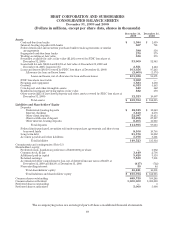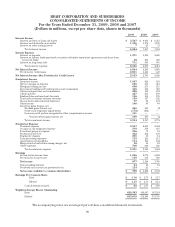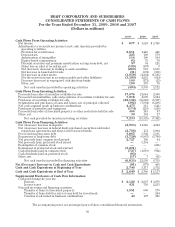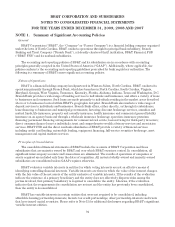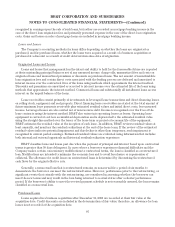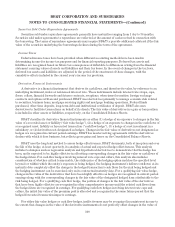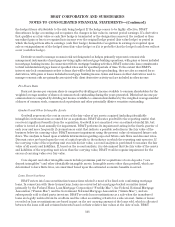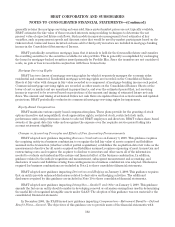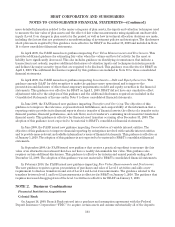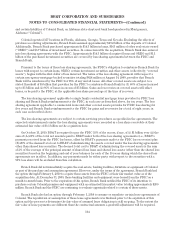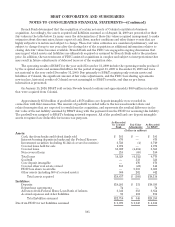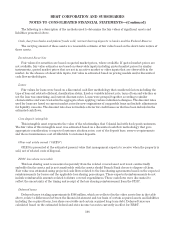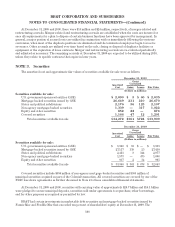BB&T 2009 Annual Report Download - page 98
Download and view the complete annual report
Please find page 98 of the 2009 BB&T annual report below. You can navigate through the pages in the report by either clicking on the pages listed below, or by using the keyword search tool below to find specific information within the annual report.BB&T CORPORATION AND SUBSIDIARIES
NOTES TO CONSOLIDATED FINANCIAL STATEMENTS—(Continued)
In determining the acquisition date fair value of purchased loans, and in subsequent accounting, BB&T
generally aggregates purchased loans into pools of loans with common risk characteristics. Expected cash flows
at the acquisition date in excess of the fair value of loans are recorded as interest income over the life of the loans
using a level yield method if the timing and amount of the future cash flows of the pool is reasonably estimable.
Subsequent to the acquisition date, increases in cash flows over those expected at the acquisition date are
recognized as interest income prospectively. Decreases in expected cash flows after the acquisition date are
recognized by recording an allowance for loan losses.
Covered Assets and Related FDIC Loss Share Receivable
Assets subject to loss sharing agreements with the Federal Deposit Insurance Corporation (“FDIC”) are
labeled “covered” on the balance sheet and include certain loans, securities and other assets.
The acquisition date fair value of the reimbursement the Company expected to receive from the FDIC under
those agreements was recorded in the FDIC loss share receivable on the Consolidated Balance Sheet. The fair
value of the FDIC loss share receivable is estimated using a discounted cash flow methodology. The discount rate
used in this calculation was determined using a risk-free yield curve plus a premium reflecting the uncertainty
related to the timing of cash flows. The income statement effects of the FDIC loss share receivable are included
in other income and include the accretion due to discounting and changes in expected reimbursements. Decreases
in expected reimbursements will be recognized in income prospectively consistent with the approach taken to
recognize increases in cash flows on covered loans. Increases in expected reimbursements will be recognized in
income in the same period that the allowance for credit losses for the related loans is recognized.
Nonperforming Assets
Nonperforming assets include non-accrual loans and leases and foreclosed property. Foreclosed property
consists of real estate and other assets acquired as a result of customers’ loan defaults. BB&T’s policies related to
when loans are placed on nonaccrual status conform to guidelines prescribed by bank regulatory authorities.
Commercial loans and leases are placed on nonaccrual status when it is probable that principal or interest is not
fully collectible, or generally when principal or interest becomes 90 days past due, whichever occurs first. Sales
finance loans, revolving credit loans, direct retail loans and mortgage loans are placed on nonaccrual status at
varying intervals, based on the type of product, when principal and interest becomes between 90 days and 180
days past due. Specialized lending loans are placed on nonaccrual status generally when principal and interest
becomes 90 days past due. Certain loans past due 90 days or more may remain on accrual status if management
determines that it does not have concern over the collectibility of principal and interest. Generally, when loans
are placed on nonaccrual status, interest receivable is reversed against interest income in the current period.
Interest payments received thereafter are applied as a reduction to the remaining principal balance as long as
concern exists as to the ultimate collection of the principal. Loans and leases are removed from nonaccrual status
when they become current as to both principal and interest and concern no longer exists as to the collectibility of
principal and interest.
Assets acquired as a result of foreclosure are carried at the lower of cost or net realizable value. Net
realizable value equals fair value less estimated selling costs. Cost is determined based on the sum of unpaid
principal, accrued but unpaid interest if not required to be reversed and acquisition costs associated with the loan.
Any excess of cost over net realizable value at the time of foreclosure is charged to the allowance for loan and
lease losses. Generally, such properties are valued periodically and if the carrying value is greater than the net
realizable value, a valuation reserve is established. Routine maintenance costs, declines in market value and net
losses on disposal are included in other noninterest expense.
Allowance for Loan and Lease Losses and Reserve for Unfunded Lending Commitments
The allowance for loan and lease losses and reserve for unfunded lending commitments are management’s
best estimate of probable credit losses that are inherent in the loan and lease portfolios and off-balance sheet
98



